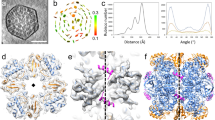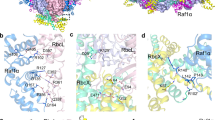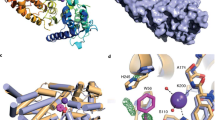Abstract
Activation of ribulose-1,5-bisphosphate carboxylase oxygenase (Rubisco; EC 4.1.1.39) by CO2 involves carbamylation of Lys 201 and the subsequent binding of a magnesium ion to complete the active site. The refined crystal structure of activated Rubisco shows that the magnesium ligands are Asp 203, Glu 204, the carbamate of Lys 201, and three water molecules. Structural differences between the unactivated and activated forms are minimal. Substrate binding replaces water ligands around the metal and triggers substantial structural changes in loops covering the active site. This leads to a contraction and tightening of the structure of the large subunits with the movements transmitted to and modulated by the small subunits.
This is a preview of subscription content, access via your institution
Access options
Subscribe to this journal
Receive 12 print issues and online access
$189.00 per year
only $15.75 per issue
Buy this article
- Purchase on Springer Link
- Instant access to full article PDF
Prices may be subject to local taxes which are calculated during checkout
Similar content being viewed by others
References
Andrews, T.J. & Lorimer, G.H. In The biochemistry of plants. vol 10 (ed. Hatch, M.D.) 121–201 (Academic Press, Orlando, Florida, 1987).
Hartman, F.C. & Harpel, M.R. Structure, function, regulation, and assembly of ribulose-1,5-bisphosphate carboxylase/oxygenase. A. Rev. Biochem. 63, 197–234 (1994).
Lorimer, G.H., Badger, M.R. & Andrews, T.J. The activation of ribulose-1,5-bisphosphate carboxylase by carbon dioxide and magnesium ions. Equilibria, kinetics, a suggested mechanism, and physiological implications. Biochemistry 15, 529–536 (1976).
Portis, A.R. Rubisco activase. Biochim. biophys. Acta 1015, 15–28 (1990).
Schneider, G., Lindqvist, Y. & Lundqvist, T. Crystallographic refinement and structure of ribulose-1,5-bisphosphate carboxylase from Rhodospirillum rubrum at 1. 7 Å resolution. J. molec. Biol. 211, 989–1008 (1990).
Lundqvist, T. & Schneider, G. Crystal structure of the ternary complex of ribulose-1,5-bisphosphate carboxylase, Mg(ll), and activator CO2 at 2.3 Å resolution. Biochemistry 30, 904–908 (1991).
Pierce, J., Tolbert, N.E. & Barker, R. Interaction of ribulosebisphosphate carboxylase/oxygenase with transition-state analogues. Biochemistry 19, 934–942 (1980).
Andersson, I. et al. Crystal structure of the active site of ribulosebisphosphate carboxylase. Nature 337, 229–234 (1989).
Knight, S., Andersson, I. & Brändén, C.-I. Crystallographic analysis of ribulose 1,5-bisphosphate carboxylase from spinach at 2.4 Å resolution: subunit interactions and the active site. J. molec. Biol. 215, 113–160 (1990).
Schreuder, H.A. et al. Crystal structure of activated tobacco Rubisco complexed with the reaction-intermediate analogue 2-carboxy-arabinitol 1,5-bisphosphate. Prot. Sci. 2, 1136–1146 (1993).
Newman, J., Brändén, C.-I. & Jones, A. Structure determination and refinement of ribulose-1,5-bisphosphate carboxylase/oxygenase from Synechococcus PCC6301. Acta Crystallogr. D49, 548–560 (1993).
Newman, J. & Gutteridge, S., The X-ray structure of Synechococcus ribulose-bisphosphate carboxylase/oxygenase-activated quaternary complex at 2.2 Å resolution. J. biol. Chem. 268, 25876–25886 (1990).
Curmi, P.M., Cascio, D., Sweet, R.M., Eisenberg, D. & Schreuder, H. Crystal structure of the unactivated form of ribulose-1,5-bisphosphate carboxylase oxygenase from tobacco refined at 2.0 Å. J. biol. Chem. 267, 16980–16989 (1992).
Schreuder, H.A. et al. Formation of the active site of ribulose-1,5-bisphosphate carboxylase/oxygenase by a disorder-order transition from the unactivated to the activated form. Proc. natn. Acad. Sci. U.S.A. 90, 9968–9972 (1993).
Edmondson, D.L., Kane, H.J. & Andrews, T.J. Substrate isomerization inhibits ribulose bisphosphate carboxylase/oxygenase during catalysis. FEBS Lett. 260, 62–66 (1990).
Andrews, T.J. & Kane, H.J. Pyruvate is a byproduct of catalysis by ribulose bisphosphate carboxylase/oxygenase. J. biol. Chem. 266, 9447–9452 (1991).
Zhu, G. & Jensen, R.G. Fallover of ribulose 1,5-bisphosphate carboxylase/oxygenase activity. Plant Physiol. 97, 1354–1358 (1991).
Edmondson, D.L., Badger, M.R. & Andrews, T.J. Slow inactivation of ribulose-bisphosphate carboxylase during catalysis is caused by accumulation of a slow, tight-binding inhibitor at the catalytic site. Plant Physiol. 93, 1390–1397.(1990).
Johal, S., Partridge, B.E. & Chollet, R. Structural characterization and the determination of negative cooperativity in the tight binding of 2-carboxyarabinitol bisphosphate to higher plant ribulose bisphosphate carboxylase. J. biol. Chem. 260, 9894–9904 (1985).
Zhu, G. & Jensen, R.G. Status of the substrate binding sites of ribulose bisphosphate carboxylase as determined with 2-C-carboxyarabinitol 1,5-bisphosphate. Plant Physiol. 93, 244–249 (1990).
Alber, T. et al. On the three-dimensional structure and catalytic mechanism of triose phosphate isomerase. Phil. Trans. R. Soc. Lond. B293, 159–171 (1981).
Otwinowski, Z. Data Collection and Processing, Proceedings of the CCP4 Study Weekend, 56–62 (Daresbury Laboratory, Warrington, UK 1993).
Brünger, A.T. X-PLOR, version 3.1. Yale University Press, New Haven and London (1992).
Brünger, A.T. The free R value: a novel statistical quantity for assessing the accuracy of crystal structures. Nature 355, 472–474 (1992).
Engh, R.A. & Huber, R. Accurate bond and angle parameters for X-ray protein structure refinement. Acta Crystallogr. A47, 392–400 (1991).
Jones, T.A., Zou, J.-Y., Cowan, S.W. & Kjeldgaard, M. Improved methods for building protein models in electron density maps and the location of errors in these models. Acta Crystallogr. A 47, 110–119 (1991).
Laskowski, R.A., MacArthur, M.W., Moss, D.S. & Thornton, J.M. PROCHECK: a program to check the stereochemical quality of protein structures. J. appl. Crystallogr. 26, 283–291 (1993).
Kraulis, P.J. MOLSCRIPT: a program to produce both detailed and schematic plots of protein structures. J. appl. Crystallogr. 24, 946–950 (1991).
Merritt, E.A. & Murphy, M.E.P., Raster3D Version 2.0, a program for photorealistic molecular graphics. Acta Crystallogr. D50 869–973 (1994).
Author information
Authors and Affiliations
Rights and permissions
About this article
Cite this article
Taylor, T., Andersson, I. Structural transitions during activation and ligand binding in hexadecameric Rubisco inferred from the crystal structure of the activated unliganded spinach enzyme. Nat Struct Mol Biol 3, 95–101 (1996). https://doi.org/10.1038/nsb0196-95
Received:
Accepted:
Published:
Issue Date:
DOI: https://doi.org/10.1038/nsb0196-95
This article is cited by
-
Grafting Rhodobacter sphaeroides with red algae Rubisco to accelerate catalysis and plant growth
Nature Plants (2023)
-
Cooperative insertion of CO2 in diamine-appended metal-organic frameworks
Nature (2015)
-
The significance of magnesium for crop quality
Plant and Soil (2013)



